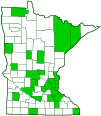brickwork woodlouse
(Porcellio spinicornis)
Conservation • Description • Habitat • Ecology • Distribution • Taxonomy
Conservation Status |
|
|||||||
| IUCN Red List | not listed |
|||||||
| NatureServe | not listed |
|||||||
| Minnesota | not listed |
|||||||
Description |
||
Brickwork woodlouse is a large, exotic woodlouse. It is native to Europe, where it is widespread and common. It was introduced into North America, where it is now naturalized. It occurs across southern Canada. In the United States it occurs from Maine to New Jersey, west to North Dakota and South Dakota, with a few scattered occurrences in the west. It is not uncommon in Minnesota. It favors dry areas with limey (calcareous) surfaces. It is found in limestone quarries, on limestone pavement, in loosely mortared walls, and often in human houses. It is sometimes found on the bark of apple, lime, and basswood trees, all of which have calcareous bark. It is active at night, when it can be found on the surface. During the day it remains concealed, often under a rock or log. Adults are ⅜″ to ⅝″ (10 to 15 mm) in length. The body is oval in outline and more or less compressed above. It is rough or granular due to the presence of numerous rounded bumps (tubercles). It is yellowish with dark brown to almost black mottling, and a dark brown to almost black stripe in the middle (middorsal) bordered on each side by bright yellow markings. One imaginative describer likened the pattern to brickwork, and this is the source of this species’ common name. The head is about twice as wide as long. It is fused to but not hidden under the first segment of the thorax. It has three lobes in front: a broadly rounded lobe in the center, and a longer, narrower, rounded lobe on each side. There are two widely spaced eyes. Each eye is a tight grouping of up to 30 dark-colored simple eyes (ocelli). The antennae are long. The end section of each antenna has two distinct segments. The first segment is a little longer than the second. The thorax (pereon) is large and has seven segments of slightly unequal length. There is a single jointed leg on each side of each segment. The upper exoskeletal plate (tergite) on each thoracic segment and the first five abdominal segments is expanded on each side into a thin, flat, lateral extension (epimeron). The rear angle on each epimeron extends rearward. On the first thoracic tergite, the front angle on each side extends forward. The abdomen (pleon) is much smaller and has six segments, all of which are distinct. The junction between the pereon and the pleon is smooth, not stepped. The lateral portions of the first two abdominal segment are concealed beneath the seventh thoracic segment. The third, fourth, and fifth segments have prominent, well developed, epimera. The last segment, the sixth, is called the telson. The telson is triangular and does not extend beyond the epimera of the fifth segment. On each side of the telson there is an elongated appendage, called a uropod. The uropods are lance-shaped and project well beyond the end of the body. On the under side of the abdomen there are just 2 pairs of pleopodial lungs. They appear as white dots on the first and second abdominal segments. The legs are long relative to other families of woodlice. |
||
Size |
||
Total length:⅜″ to ⅝″ (10 to 15 mm) |
||
Similar Species |
||
Habitat |
||
Dry areas with limey (calcareous) surfaces; limestone quarries, limestone pavement, mortared walls, human houses, and the bark of apple, lime, and basswood trees. |
||
Ecology |
||
Season |
||
|
||
Behavior |
||
Unlike pill woodlice (Family Armadillidae), brickwork woodlouse cannot roll into a ball. |
||
Lifespan |
||
|
||
Life Cycle |
||
|
||
Food |
||
|
||
Distribution |
||||
|
Sources |
|||
| 7/6/2022 | ||||
Nativity |
||||
Native to Europe |
||||
Occurrence |
||||
|
||||
Taxonomy |
|||
| Subphylum | Crustacea (crustaceans) | ||
| Superclass | Multicrustacea (typical crustaceans) | ||
| Class | Malacostraca (malacostracans) | ||
| Subclass | Eumalacostraca (decapods, isopods, and allies) | ||
| Superorder | Peracarida (amphipods, isopods, and allies) | ||
Order |
Isopoda (Isopods) | ||
Suborder |
Oniscidea (woodlice, pillbugs, and rock slaters) | ||
Infraorder |
Holoverticata (woodlice and pillbugs) | ||
Zoosection |
Crinocheta | ||
Family |
Porcellionidae | ||
Genus |
Porcellio | ||
Synonyms |
|||
|
|||
Common Names |
|||
brickwork woodlouse painted woodlouse |
|||
Glossary
Calcareous
Alkaline; rich in limestone; containing a high proportion of calcium carbonate.
Ocellus
Simple eye; an eye with a single lens. Plural: ocelli.
Tergum; tergite
The upper (dorsal), hardened plate on a segment of the thorax or abdomen of an arthropod or myriapod. Plural: terga.
Tubercle
On plants and animals: a small, rounded, raised projection on the surface. On insects and spiders: a low, small, usually rounded, knob-like projection. On slugs: raised areas of skin between grooves covering the body.
Uropod
On some crustaceans, a pair of appendages on the sixth and final abdominal segment. On lobsters and similar species, it forms part of the tail fan.
Visitor Photos |
|||||
Share your photo of this crustacean. |
|||||
| This button not working for you? Simply email us at info@MinnesotaSeasons.com. Attach one or more photos and, if you like, a caption. |
|||||
Evin |
|||||
I see this one before but the are usually Deceased this one was on the move. What is it? |
|||||
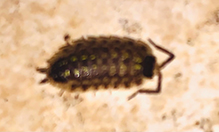 |
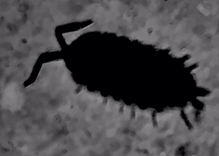 |
||||
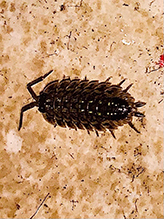 |
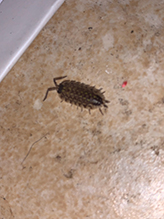 |
||||
Greg Watson |
|||||
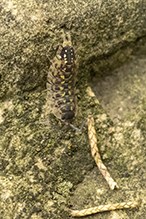 |
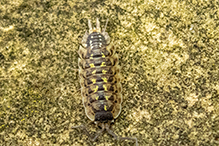 |
||||
MinnesotaSeasons.com Photos |
|||||
|
|||||

Slideshows |
||
| Woodlouse Andree Reno Sanborn |
||
 |
||
| Porcellio spinicornis Lloyd Davies |
||
 |
||
About
Porcellio spinicornis Painted Woodlouse |
||

Visitor Videos |
|||
Share your video of this crustacean. |
|||
| This button not working for you? Simply email us at info@MinnesotaSeasons.com. Attach a video, a YouTube link, or a cloud storage link. |
|||
Other Videos |
|||
| Watching Brickwork'ers (Porcellio Spinicornis). I spy on isopods! Isopod Corner |
|||
About
Oct 4, 2021 In this video we observe a colony of Porcellio Spinicornis "hard at work". Take a few minutes to watch these cute little isopods with some of my isopods. Enjoy! |
|||
| Dornfühlerassel (Porcellio spinicornis) mankalephallang |
|||
About
Jan 2, 2012 A special snowbug comes accross. Filmed at the 02.01.2012 in Brandenburg. Eine Dornfühlerassel läuft über den Weg. Gefilmt am 02.01.2012 in Brandenburg |
|||
| Porcellio Spinicornis Stínka skvrnitá krajtl |
|||
About
Jun 22, 2015 |
|||


Created: 7/6/2022
Last Updated:
